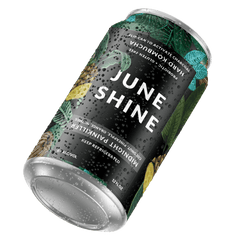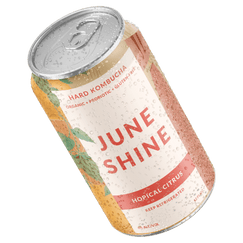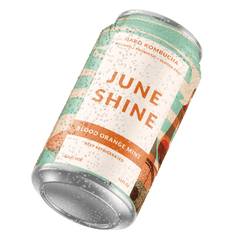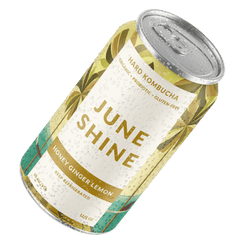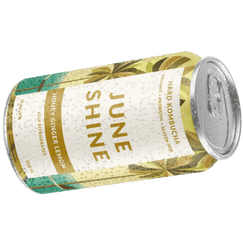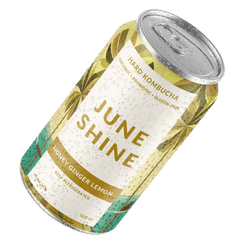Jun Kombucha: What Is It and How Is It Different?

You’ve heard of kombucha, but you may not have heard of Jun kombucha. We like to call it the champagne of kombuchas, because Jun kombucha has a few properties that separate it from its traditional booch.
If you’re a kombucha newbie, Jun is a fantastic first introduction to the booch world. If you’re a kombucha extraordinaire, it’s still worth sipping on. Either way, here at JuneShine, we believe Jun kombucha is the way to go.
What Is Traditional Kombucha?
Traditional kombucha is made by brewing and fermenting tea—almost always black tea. The black tea gives this beverage a more pronounced taste, and to sweeten the bitterness of the tea and spur on fermentation, cane sugar is added to the mix.
How Traditional Kombucha Is Made
Once tea and sugar have been brewed in boiling water, the mixture is transferred to a large container to cool. Once it is room temperature, it is added to the fermenting container, and the SCOBY (aka the mother of kombucha) joins the party.
The container is covered, usually with cheesecloth though not always. The top needs to keep unwanted bugs and bacteria out, but it also must allow air to pass through for fermentation to occur.
This type of traditional kombucha has a longer fermentation time, ranging from seven to 30 days. It does best in warm (72 - 80 degrees Fahrenheit), humid conditions. As the tea ferments, the SCOBY will float atop, or sometimes within, the mixture.
While doing this, the bacteria and yeast in the SCOBY eat the sugar, and carbon dioxide is released. This is how kombucha gets the effervescent fizziness it’s known for.
When the brewer sees the desired amount of bubbles and is satisfied with its level of sweetness, the kombucha is ready to be bottled and refrigerated. Airtight bottling and refrigeration are essential in homemade kombucha in order to prevent further fermenting.
What Does Traditional Kombucha Taste Like?
If you’ve never tried kombucha before, the traditional variety can have a sharp taste. Some love it; others not so much. Somewhat similar to sparkling apple cider, traditional booch has the bright fizziness that you would expect from a carbonated drink.
Depending on how long the particular batch fermented and how much sugar was added, you might find varying levels of sweetness. Some tasters also think traditional kombucha has a slight vinegary taste. Sometimes brewers flavor their kombuchas with fruit juices and spices to flavor their brews as well.
What Is Jun Kombucha?
Jun (which rhymes with run) kombucha is similar to the traditional variety, but its makeup leads to a very different product with a smoother, more distinguished flavor.
How Jun Kombucha Is Made
Opposed to the black tea and sugar used for traditional kombucha, Jun kombucha is started by brewing green tea. Once the water is boiled, natural honey is added rather than the refined sugar used for traditional kombucha.
After the tea has cooled to room temperature, the liquid is transferred to a fermenting vessel, and the SCOBY is added. The yeast and bacteria cultures in Jun SCOBY feed off of honey rather than cane sugar. Like the traditional methods, this kombucha is most commonly fermented in a glass jar and covered with breathable fabric.
The process of fermentation for Jun kombucha is much shorter, only taking three to five days. Instead of warm, humid conditions, this variety prefers cooler temperatures (between 65 and 70 degrees Fahrenheit).
For an even fizzier quality, our Jun kombucha undergoes a second fermentation. This is done by transferring the booch from a large vessel to smaller, individual containers. During this time, the bacteria replicate and release more carbon dioxide, creating more bubbles and effervescence.
What Does Jun Kombucha Taste Like?
The taste is probably our favorite part of Jun kombucha. The flavors in Jun kombucha are lighter and smoother, as honey needs much less time to break down during fermentation. The combination of lighter green tea and honey creates a booch without the sharp bite of traditional kombucha.
We also add fresh fruit juice and spices to give our Jun kombucha an extra layer of goodness. From the refreshing mango and pineapple juice in our Chili Mango flavor to acai and blueberry, the options of added flavors are endless.
Final Takeaway
We prefer Jun kombucha over the traditional recipes simply because it tastes better. The vinegary flavor that is sometimes associated with kombucha is not part of the equation here.
We also think using honey is a better, more natural choice than sugar. Honey is natural and comes with many nutritional benefits.
Here at JuneShine, we’re all about providing you with the best possible booch, which means choosing the best ingredients. We never use artificial flavors, and we think it makes a big difference. Check out all of our options, and decide for yourself.
Sources:
What to Expect the First Time You Drink Kombucha | The Kitchn
